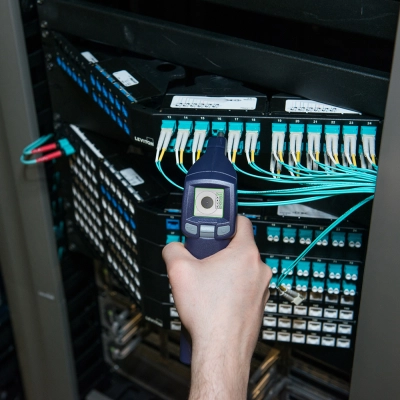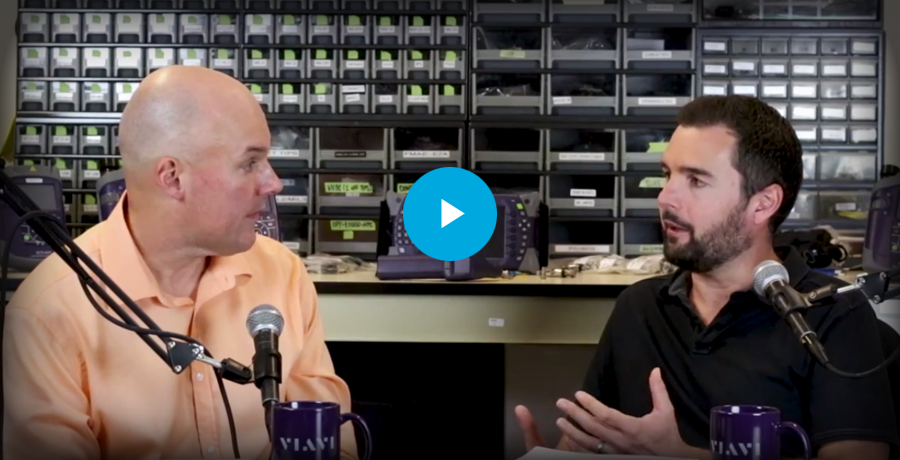What is Fiber Inspection?
Contamination is the #1 reason to troubleshoot optical networks.

Fiber Inspection is the practice of viewing the end face of a fiber optic connector by use of an optical microscope. The primary reason for fiber inspection is to ensure that the connectors are free of any defects, damage, or debris that would prevent sufficient transmission of light when mated with another connector.
Industry standards such as IEC-61300-3-35 are commonly referenced when determining acceptance criteria for an acceptable fiber connector end face.
What are the Benefits of Inspecting Your Fiber End Faces?
- reduced network downtime
- reduced troubleshooting
- optimized signal performance
- prevention of network damage.
Contaminated or dirty fiber is the number-one cause of fiber optic network degradation, including permanent equipment damage. As a result, proactive fiber optic inspection programs support the deployment of large-scale fiber optic network and fiber optic cabling initiatives and ensure reliable, high-quality delivery of high-speed, high-capacity, broadband services. VIAVI Solutions’ fiber optic inspection product line, including fiber inspection probes and fiber optic inspection scopes (or simply known as fiber microscopes), offers easy-to-use fiber optic inspection tools that, among other applications, allow field technicians, network managers, IT professionals and contractors to determine the cleanliness of fiber connections when they install the network. VIAVI fiber optic inspection and cleaning solutions also offer the industry’s leading fiber inspection microscopes, fiber inspection probes, and automated fiber analysis software necessary for these programs.
Fiber inspection and cleaning are critical components in a comprehensive fiber deployment and operation strategy. VIAVI fiber optic inspection solutions provide a full suite of optical inspection and cleaning solutions that address the needs of fiber component and system manufacturers, service providers, enterprises, and military and aerospace networks.
Many industry associations maintain guidance for fiber optic inspection and fiber optic cleaning practices and procedures, including the Fiber Optic Association and Bicsi and the Fiber Optic Association, Inc.
Aiding the industry effort to guarantee a common level of performance from the many fiber optic connectors found in today’s fiber-rich, high-connectivity networks, the International Electrotechnical Commission (IEC) created IEC 61300-3-35. This standard specifies pass/fail requirements for connector end-face quality before connection and supports optimized product and network performance throughout the fiber optic life cycle when compliant with the standard at each stage. Because of the variables associated with manual fiber optic inspection, compliance requires automated end face inspection using analysis software programmed to specified pass/fail criteria for connector quality. Automation of the systematic proactive inspection process using programmed analysis software eliminates the variables associated with manual fiber inspection and provides a documented record of the quality of the connector end face at the point of installation, all in a 100-percent repeatable and reliable process. Combined, these benefits make automated end face fiber optic inspection the most effective method available to assure and certify compliance to the IEC Standard throughout the fiber optic product life cycle and achieve the promise of fiber optic networks.
It is widely known in the fiber optic industry that scratches, defects, and dirt on fiber optic connector end faces negatively impact network performance. If dirty and damaged end faces are not dealt with systematically, these defects can degrade network performance and eventually take down an entire link. In the effort to guarantee a common level of performance from the connector, the IEC developed Standard 61300-3-35 which specifies pass/fail requirements for end face quality fiber inspection before connection.
Check out our 14-episode series
- Episode 1: Inspect Before You Connect Introduction
- Episode 2: Proactive vs. Reactive Inspection
- Episode 3: Importance of Inspecting BOTH Sides of a Connection
- Episode 4: The Importance of Inspecting New Fiber Connectors
- Episode 5: The Importance of Inspecting Test Reference Cords
- Episode 6: Cleaning Stick vs. a Clicker
- Episode 7:Static Charge and Contamination
- Episode 8: Understanding Fiber Cleaning Solvents
- Episode 9: The Importance of Reliable Cleaning Tools
- Episode 10: Understanding the IEC-61300-3-35 Standard
- Episode 11: The Importance of Automated Pass/Fail Analysis for Fiber Inspection
- Episode 12: The Importance of Documenting Fiber Inspection Results
- Episode 13: The Importance of Investing in Inspection and Cleaning Today
- Episode 14: Understanding Inspecting and Cleaning MPO Connector
IEC Standard 61300-3-35 is a global, common set of requirements for fiber optic connector end face quality designed to guarantee insertion loss and return loss performance. The standard contains pass/fail requirements for fiber inspection and analysis of the end face of an optical connector, specifying separate criteria for different types of connections (for example, SM-PC, SM-UPC, SM-APC, MM, and multi-fiber connectors). The quality values used in the IEC Standard are the result of years of extensive testing of scratched, damaged, or dirty optical connectors conducted by a coalition of industry experts including component suppliers, contract manufacturers, network equipment vendors, test equipment vendors, and services providers. As a result, the IEC Standard represents a reliable and repeatable standard of quality that guarantees a common level of product and network performance throughout the entire fiber optic life cycle. Receive full details on the IEC Standard by purchasing copies of the copyrighted document at www.ansi.org and searching for “61300-3-35.”
The IEC Standard is designed to guarantee a common level of fiber optic connector performance, but it only works when compliance exists every time connectors are mated. In the industry-wide effort to comply with the standard, current fiber optic handling best practices recommend systematic proactive end face fiber inspection before connection.
VIAVI Solutions reinforces this practice with its widely used proactive inspection model—Inspect Before You Connect (IBYC). While current research shows that the IBYC process is reducing the installation of contaminated fibers and improving network performance, the variables associated with manual fiber inspection (for example, technician eyesight and expertise, ambient lighting, and display conditions), keep manual fiber optic inspection from being a 100-percent reliable and repeatable method of assuring a common level of end face quality and IEC compliance. In addition, because no record of the end face condition is created, certification of quality at the point of installation using manual fiber optic inspection is impractical.
Recognizing the variables and limitations of manual inspection, the IEC used the programmable fiber inspection and analysis software from VIAVI Solutions to develop the standard. Automating the fiber optic inspection process using programmable software eliminates the variables associated with manual fiber inspection and provides a documentable and certifiable record of the quality of the connector end face at the point of installation. Because the IEC standard requires the tester to know the exact location and size of surface defects (for example, scratches, pits, and debris), automated fiber optic inspection and analysis using software programmed to specified pass/fail criteria is the only 100-percent reliable and repeatable way to achieve and certify IEC or customer-specified compliance for fiber optic end face quality—which is also the only way to realize the speed and bandwidth performance promised by next-generation networks.
VIAVI-developed solutions automate the pass/fail process using research-based parameters extracted from nearly 20 years of testing on a constantly expanding database of fibers and fiber devices (for example, SM, MM, Ribbon, E2000, SFP/XFP, bend-insensitive fibers, lenses, and other interfaces). Conducted by a coalition of industry experts, including component suppliers and contract manufacturers, this extensive testing combined with widespread use by component manufacturers, integrators/CMs, OEMs, third-party installers, and service providers make fiber optic inspection solutions from VIAVI the current proven industry standard for automated objective fiber optic connector end face fiber inspection. The combination of common requirements (IEC 61300-3-35) and automated fiber inspection and analysis from VIAVI have measurably impacted product quality throughout the supply chain.
- A single particle mated into the core of a fiber can cause significant back reflection, insertion loss and even equipment damage
- Typical debris on a fiber connector endface can be 2 - 15µm and is only visible with a fiber optic probe microscope
- Inspecting BOTH sides of the fiber connection is the ONLY WAY to ensure that it will be free of contamination and defects
- Inspecting and cleaning connectors, test ports and reference cords before testing network connectors prevents cross-contamination
